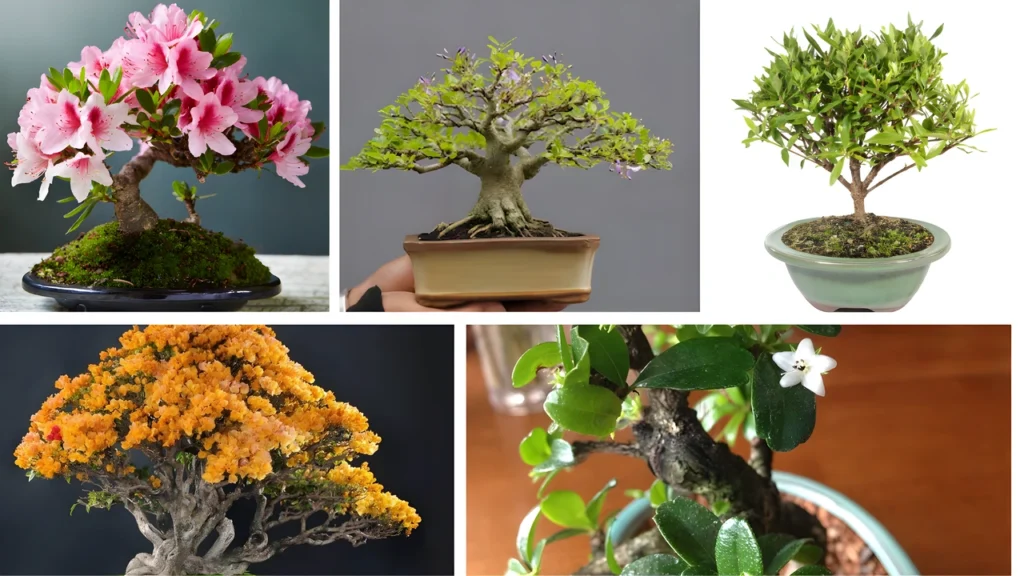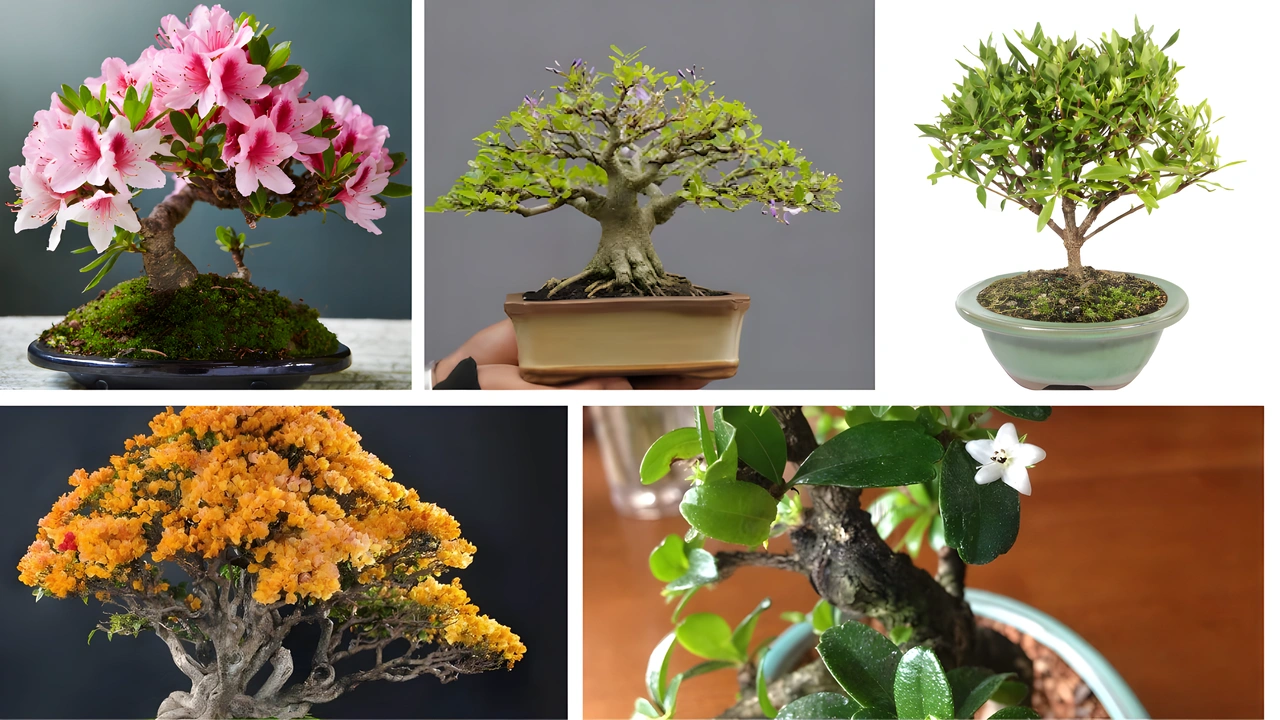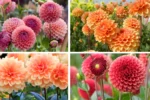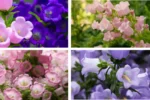Join on WhatsApp
Get the latest updates directly on WhatsApp – motivation, news & more!
Flowering bonsai species are more than just miniature trees — they are living art forms that offer a sense of serenity, sophistication, and natural beauty right inside your home. These captivating trees combine the intricate care of bonsai cultivation with the colorful allure of flowering plants, making them striking indoor accents. If you’re looking to bring a vibrant yet elegant atmosphere into your interior, these ten flowering bonsai species are perfect choices. This guide explores not only the species themselves but also how each contributes to beauty and elegance in indoor spaces. Whether you’re a bonsai enthusiast or just starting out, you’ll find the ideal plant to suit your space and style.

Why Choose Flowering Bonsai Species for Indoor Spaces
Choosing flowering bonsai species for indoor spaces is a decision that enhances more than just décor — it transforms your environment into a peaceful, nature-inspired retreat. These species are carefully cultivated to bloom in miniature form, offering seasonal color, subtle fragrance, and year-round visual appeal.
Unlike traditional houseplants, flowering bonsai species require patience and attention, but the reward is unparalleled: delicate blossoms atop perfectly shaped trunks and branches. Their size makes them ideal for display on desks, windowsills, or coffee tables, turning everyday spaces into living showcases of nature’s beauty.
Moreover, many flowering bonsai species are symbolic in different cultures, representing concepts like peace, renewal, or prosperity. When placed in indoor spaces, they bring not just natural beauty and elegance but also a deeper connection to tradition and mindfulness.
Caring for Flowering Bonsai Species Indoors
Successful cultivation of flowering bonsai species that bring natural beauty and elegance to indoor spaces starts with understanding their specific needs. Each species may vary slightly in care requirements, but general principles apply.
Most flowering bonsai species require bright, indirect light. South- or east-facing windows work best. Watering must be done carefully; bonsai trees prefer slightly moist but not soggy soil. Overwatering can lead to root rot, while underwatering causes stress and poor blooming.
Humidity is another critical factor. Since many flowering bonsai species originate from tropical or temperate climates, they benefit from occasional misting or a humidity tray. Fertilizing during the growing season promotes healthy flowering, and pruning helps shape the bonsai and encourage more blooms.
Keeping your bonsai in a consistent temperature range and avoiding cold drafts or heating vents will also ensure it continues to thrive indoors.
Top 10 Flowering Bonsai Species for Indoor Beauty and Elegance
Each of the following flowering bonsai species offers unique features that make them ideal for adding natural beauty and elegance to your indoor spaces. Let’s explore them in more detail:
| Bonsai Species | Flower Color | Bloom Season | Ideal Indoors? | Special Feature |
|---|---|---|---|---|
| Azalea (Rhododendron) | Pink, White, Red | Spring | Yes | Dense blooms and vibrant colors |
| Serissa Japonica | White | Year-round (indoors) | Yes | Called “Tree of a Thousand Stars” |
| Bougainvillea | Purple, Pink | Spring–Fall | Yes (warm rooms) | Paper-like bracts, tropical appeal |
| Fukien Tea (Carmona) | White | Year-round | Yes | Small white flowers and glossy leaves |
| Gardenia | White | Late Spring–Summer | Yes | Strong fragrance and lush blooms |
| Cherry Blossom (Prunus) | Pink | Spring | Yes (with dormancy) | Classic Japanese floral symbol |
| Jasmine Bonsai | White | Summer | Yes | Intense fragrance and climbing growth |
| Hibiscus Bonsai | Red, Yellow | Summer–Fall | Yes | Tropical, large flowers indoors |
| Camellia | Pink, Red | Winter–Spring | Yes | Elegant, rose-like blooms |
| Wisteria Bonsai | Purple, Blue | Spring | Yes (large pots) | Cascading, dramatic floral display |
1. Azalea Bonsai – A Burst of Colorful Blooms
Azalea bonsai is one of the most popular flowering bonsai species that bring natural beauty and elegance to indoor spaces. Its breathtaking flowers bloom in shades of pink, red, white, and even purple. When cared for correctly, azalea bonsai will reward you with a spring explosion of color.
Azaleas thrive indoors in filtered light and need acidic soil to bloom at their best. Regular pruning after flowering keeps the bonsai shape balanced and promotes future blooming. Because of their showy display, azalea bonsai makes an excellent centerpiece for your home or office.
2. Serissa Japonica – The Tree of a Thousand Stars
Nicknamed “Tree of a Thousand Stars,” Serissa Japonica is one of the few flowering bonsai species that can bloom indoors year-round. Its tiny white flowers resemble scattered stars, creating a delicate and elegant look.
This bonsai species is perfect for bringing natural beauty into indoor spaces that receive moderate sunlight. It’s sensitive to sudden changes in environment, so consistency in watering and location is key. Its refined appearance makes it a striking indoor accent, especially in minimalist or Zen-inspired interiors.
3. Bougainvillea Bonsai – Tropical Color Indoors
Bougainvillea bonsai is ideal for those who love bold, vibrant colors. Though often associated with outdoor settings, this flowering bonsai species can thrive indoors in warm, sunny spaces.
With its thin, paper-like bracts in hues of purple, magenta, and orange, Bougainvillea adds a splash of tropical beauty and elegance to indoor spaces. It prefers a well-lit window and benefits from occasional pruning to maintain shape and encourage blooming.
4. Fukien Tea Bonsai – Beauty with Year-Round Blooms
Fukien Tea bonsai is a true classic among flowering bonsai species. It’s one of the few that blooms year-round with small white flowers and glossy dark green leaves.
Perfect for adding natural beauty and sophistication to indoor spaces, Fukien Tea also produces small red berries after blooming. It thrives in warm indoor climates with consistent lighting and humidity. Because of its small leaf size and fine branching, it makes an ideal bonsai for detailed styling.
5. Gardenia Bonsai – A Fragrant Indoor Accent
Gardenia bonsai stands out for its fragrance as much as its stunning white blooms. This flowering bonsai species is ideal for indoor spaces where scent and style go hand in hand.
To achieve the best results, Gardenia bonsai needs high humidity, bright indirect light, and slightly acidic soil. Regular fertilization during its growing season (spring through summer) supports lush blooms. As a table centerpiece or bathroom accent, it delivers both beauty and elegance.
6. Cherry Blossom Bonsai – Indoor Japanese Elegance
Few trees represent natural beauty and elegance like cherry blossom bonsai. While this flowering bonsai species typically needs a dormant period, it can be grown indoors in containers if given the right seasonal care.
Its iconic pink flowers bloom in early spring, making it a seasonal standout in your indoor collection. During dormancy, place it in a cool location like an unheated room. When in bloom, it transforms indoor spaces into peaceful Japanese-inspired sanctuaries.
7. Jasmine Bonsai – Fragrance Meets Floral Charm
Jasmine bonsai is one of the most beloved flowering bonsai species due to its intense fragrance and delicate white flowers. Indoors, it brings a refreshing floral aroma to any room it inhabits.
This bonsai thrives in bright but indirect sunlight and requires regular watering during blooming season. It also enjoys high humidity, so placing a humidity tray nearby helps keep it healthy. Jasmine bonsai is especially striking in bedrooms or entryways where its scent can be appreciated.
8. Hibiscus Bonsai – Big Blooms in Small Form
For those who want larger, more tropical flowers, hibiscus bonsai is an excellent choice. This flowering bonsai species offers bold red, yellow, or pink blooms and thrives in warm, sunny indoor spots.
While hibiscus may require more frequent watering and pruning, the payoff is impressive — dramatic flowers that look striking against their small, woody trunks. They bring a tropical sense of beauty and elegance that stands out in modern or artistic indoor spaces.
9. Camellia Bonsai – Winter Blooms with Classic Grace
Camellia bonsai is ideal for bringing beauty and elegance to indoor spaces during the colder months. Its blooms resemble roses and come in shades of red, pink, and white.
Camellias need cool temperatures, indirect light, and acidic soil to thrive. They bloom in winter and early spring, offering color when most plants are dormant. Their sculptural form and classic blooms make them ideal for traditional interior aesthetics.
10. Wisteria Bonsai – A Dramatic Indoor Statement
Wisteria bonsai is among the most visually dramatic flowering bonsai species. Its cascading clusters of purple or blue flowers are simply unforgettable.
Wisteria requires more space than most bonsai due to its extensive root system, so a larger container is needed. Though slightly more demanding in terms of care, its elegance is unmatched. It’s a stunning choice for formal rooms, entry halls, or large windowsills where its hanging blossoms can be fully appreciated.
Conclusion: Choosing Flowering Bonsai Species to Elevate Indoor Spaces
Incorporating flowering bonsai species


